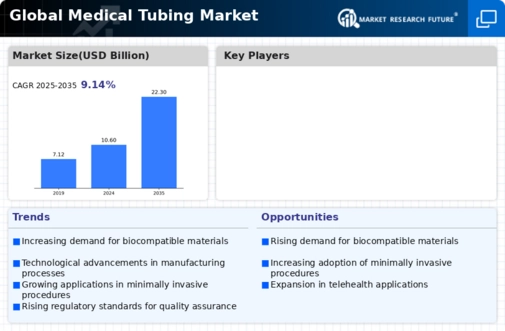Market Share
Medical Tubing Market Share Analysis
In the medical tubing market, companies employ various market share positioning strategies to establish and maintain their presence. One effective strategy is product differentiation. By offering unique products with superior features, such as enhanced flexibility, durability, and biocompatibility, companies can set themselves apart from competitors. For example, using advanced materials like silicone, thermoplastic elastomers (TPE), and polyvinyl chloride (PVC) can provide significant advantages in terms of performance and safety, making these products more attractive to healthcare providers.
Another key strategy is focusing on innovation. Companies that invest in research and development to create cutting-edge medical tubing solutions often gain a competitive edge. Innovations may include new manufacturing processes, improved coatings that reduce infection risks, or tubing designed for specific medical applications such as intravenous therapy, catheters, or surgical procedures. By continuously improving their products and staying ahead of technological advancements, companies can capture a larger market share.
Strategic partnerships and collaborations also play a crucial role in market positioning. By partnering with other companies, research institutions, or healthcare providers, medical tubing manufacturers can expand their reach and leverage additional expertise and resources. These collaborations can lead to the development of new products, entry into new markets, and enhanced credibility within the industry. Such partnerships often result in mutually beneficial outcomes, boosting the market presence of all involved parties.
Geographic expansion is another important strategy. Companies aiming to increase their market share often look to expand their operations into new regions, particularly emerging markets with growing healthcare infrastructure. By establishing a presence in countries with increasing healthcare spending and improving medical facilities, companies can tap into new customer bases and grow their market share. This may involve setting up local manufacturing units, distribution networks, or sales offices to better serve these markets.
Marketing and branding efforts are essential for positioning in the medical tubing market. Effective marketing strategies help companies build brand recognition and trust among healthcare providers and patients. This can include participating in industry conferences, exhibitions, and trade shows, as well as leveraging digital marketing tools to reach a wider audience. Strong branding and visibility can significantly impact market share by making a company’s products the preferred choice in a competitive market.
Cost leadership is another strategy employed by some companies to enhance their market position. By optimizing production processes, sourcing cost-effective materials, and achieving economies of scale, companies can offer high-quality medical tubing at competitive prices. This approach is particularly effective in price-sensitive markets where cost considerations are crucial for buyers. Offering products at lower prices without compromising on quality can attract a larger customer base and increase market share.
Customer service and support also contribute to market positioning. Companies that provide excellent customer service, including timely deliveries, technical support, and after-sales service, are likely to retain existing customers and attract new ones. Building strong relationships with customers through consistent and reliable service can lead to repeat business and positive word-of-mouth referrals, enhancing the company’s reputation and market position.
Regulatory compliance and certification are vital in the medical tubing market. Companies that ensure their products meet all necessary regulatory standards and obtain relevant certifications can gain a significant advantage. Compliance with stringent regulations ensures product safety and reliability, which are critical factors for healthcare providers. Meeting these standards can enhance a company’s credibility and trustworthiness, making their products more appealing to buyers.
Sustainability and eco-friendly practices are increasingly becoming important in market positioning. Companies that adopt sustainable manufacturing practices, use eco-friendly materials, and minimize their environmental footprint can attract environmentally conscious customers. Emphasizing sustainability in product development and marketing can differentiate a company’s offerings and appeal to a growing segment of the market that values green practices.



Leave a Comment